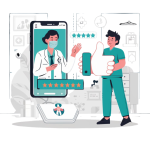
9 Ideas To Address Patient Pain Points Through Feedback Systems
In the healthcare industry, patient satisfaction is paramount. Addressing patient pain points through effective feedback systems not only enhances the patient experience but also improves overall healthcare outcomes. By systematically gathering and acting upon patient feedback, healthcare providers can identify and mitigate issues, fostering a more patient-centric approach.
These pain points can range from communication breakdowns and long wait times to inadequate facilities and a lack of empathy from healthcare providers. This article delves into nine innovative ideas to address patient pain points using patient feedback systems.
How Feedback Systems Can Help Patient Pain Points
Feedback systems play a crucial role in identifying and addressing patient pain points. By collecting real-time feedback, healthcare providers can gain valuable insights into the patient experience:
1. Implement Real-Time Feedback Mechanisms
Digital surveys and kiosks placed strategically within healthcare facilities can capture real-time feedback from patients. These systems allow patients to provide immediate input on their experience, highlighting pain points such as long wait times, inadequate facilities, or unhelpful staff.
2. Leverage Mobile Apps For Patient Feedback
Mobile apps designed for patient feedback can facilitate easy and convenient communication between patients and healthcare providers. These apps can include features like feedback forms, ratings, and the ability to report issues directly from a mobile device.
3. Conduct Regular Patient Satisfaction Surveys
Regular patient satisfaction surveys are a fundamental tool for understanding patient pain points. These surveys should be designed to cover various aspects of the patient experience, including communication, wait times, staff behavior, and facility conditions.
4. Establish Patient Advisory Councils
Patient advisory councils are composed of patients and family members who provide feedback and recommendations to healthcare providers. These councils serve as a platform for patients to voice their concerns and suggest improvements.
5. Utilize Social Media For Feedback Collection
Social media platforms offer a wealth of patient feedback that can be leveraged to identify pain points. Monitoring comments, reviews, and direct messages on platforms like Facebook, Twitter, and Instagram can provide valuable insights into patient experiences.
6. Implement Post-Visit Follow-Up Calls
Post-visit follow-up calls allow healthcare providers to gather feedback directly from patients after their appointments. These calls can address any immediate concerns and provide an opportunity for personalized patient engagement.
7. Offer Anonymous Feedback Options
Anonymous feedback options encourage patients to provide honest feedback without fear of retribution. This can be achieved through anonymous surveys, suggestion boxes, or digital platforms that ensure patient confidentiality.
8 Creating a Patient Feedback Portal
An online feedback portal allows patients to submit their feedback at any time. This portal can be integrated into the healthcare provider’s website or mobile app, making it easily accessible for patients.
9. Train Staff On Effective Feedback Management
Training healthcare staff on how to effectively collect, manage, and respond to patient feedback is crucial. This includes teaching communication skills, empathy, and the importance of patient-centric care.
Conclusion
Addressing patient pain points through feedback systems is essential for enhancing the patient experience and improving healthcare outcomes. By implementing these nine ideas, healthcare providers can create a more patient-centric approach, ensuring that patient concerns are heard and addressed promptly.
Leveraging technology, engaging patients in decision-making, and training staff on feedback management are key strategies in this endeavor.
Frequently Asked Questions (FAQs)
What Are Patient Pain Points?
Patient pain points are specific issues or challenges that patients encounter during their healthcare journey, such as long wait times, poor communication, and inadequate facilities.
How Can Feedback Systems Help In Addressing Patient Pain Points?
Feedback systems collect real-time feedback from patients, providing valuable insights into their experiences and helping healthcare providers identify and address issues promptly.
Why Is Real-Time Feedback Important In Healthcare?
Real-time feedback allows healthcare providers to address patient concerns immediately, preventing issues from escalating and improving overall patient satisfaction.
How Can Mobile Apps Enhance Patient Feedback?
Mobile apps facilitate easy and convenient communication between patients and healthcare providers, allowing patients to provide feedback, report issues, and access healthcare information on their mobile devices.
What Is The Role Of Patient Advisory Councils?
Patient advisory councils involve patients in decision-making processes, ensuring their perspectives are considered in policy and operational changes, and helping to address patient pain points more effectively.
Enhance Patient Care and NABH Compliance with LazyMonkey
LazyMonkey is your all-in-one solution for improving patient care, retaining more patients, and meeting NABH standards. Our powerful QR-based feedback tool enables you to capture real-time insights from patient feedback, discharge surveys, staff and doctor evaluations, and clinical research, while also streamlining inter-departmental communication.
Transform your healthcare facility today - reach out to us at [email protected], or request a demo here!
Elevate Your Restaurant Experience with LazyMonkey
LazyMonkey’s QR-based feedback system helps you gather real-time insights from customers, track satisfaction levels, and enhance the dining experience. Get instant feedback on your menu, service, and ambience, and make data-driven improvements to boost repeat customers and reviews.
Improve your restaurant today – reach out to us at [email protected], or request a demo here!
Empower Student Engagement and Campus Improvement with LazyMonkey
LazyMonkey offers a seamless way to gather student feedback, track satisfaction, and enhance campus life. From course evaluations to dorm feedback, our QR-based solution makes it easy to capture valuable insights and improve student retention.
Upgrade your university experience – contact us at [email protected], or request a demo here!
Streamline Feedback and Drive Performance Across Your Enterprise/Franchise with LazyMonkey
Whether you manage one or multiple locations, LazyMonkey’s QR-based feedback system helps you gather real-time employee and customer feedback. Improve operational efficiency, track satisfaction, and make data-driven decisions to enhance brand consistency and growth.
Transform your franchise today – reach out to us at [email protected], or request a demo here!
Enhance Customer Satisfaction and Service Standards in Banking with LazyMonkey
LazyMonkey empowers banks to capture real-time feedback from clients across branches. Improve customer experience, assess service quality, and ensure regulatory compliance with our QR-based solution, helping you retain clients and meet banking standards.
Elevate your bank’s customer care – contact us at [email protected], or request a demo here!
Boost Customer Engagement and Mall Satisfaction with LazyMonkey
LazyMonkey’s QR-based feedback tool enables you to collect feedback from shoppers, track satisfaction, and enhance the mall experience. Gather insights on store services, cleanliness, and entertainment to create an unmatched customer journey.














